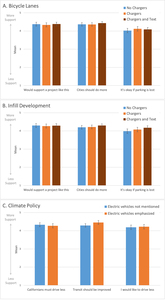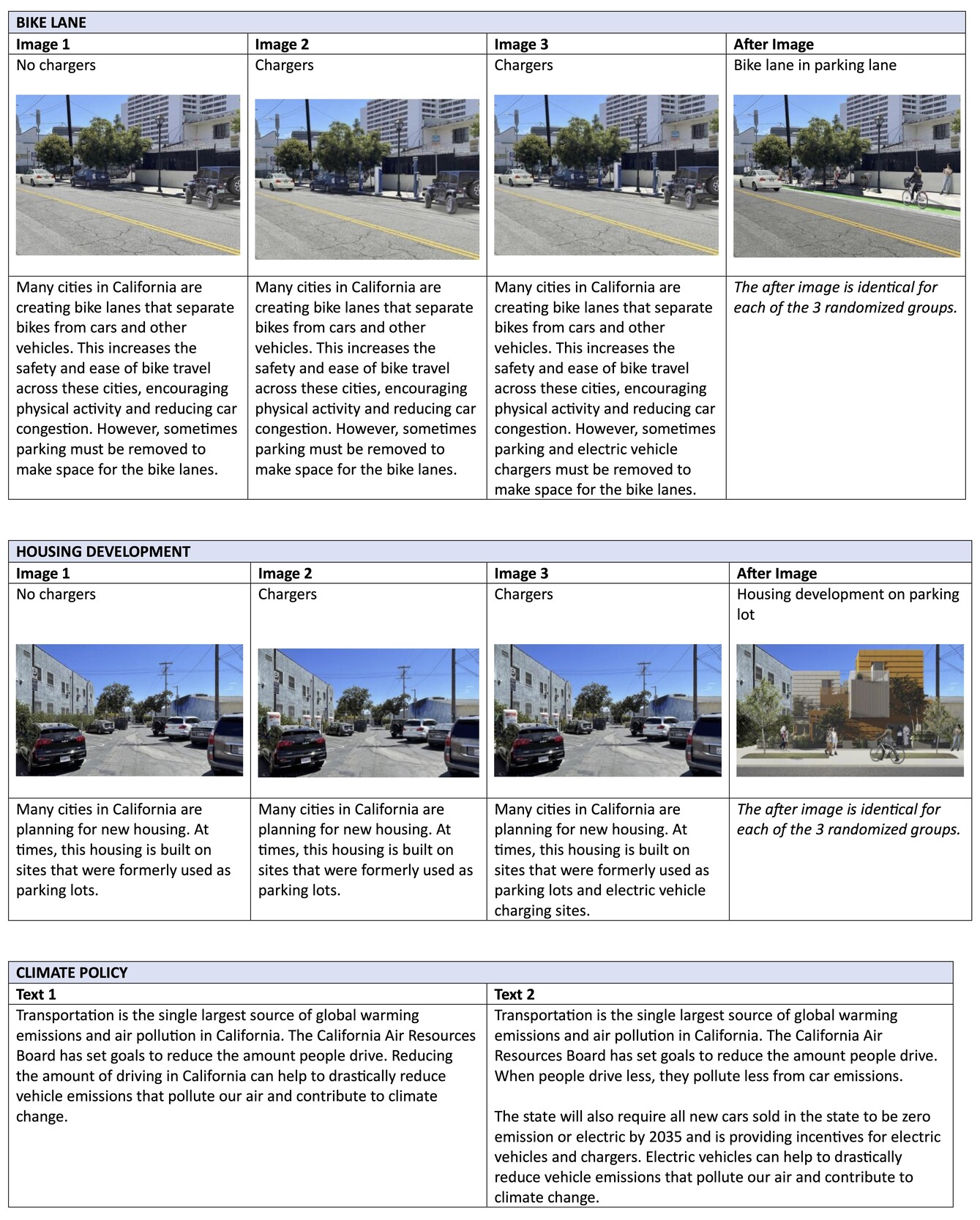1. Questions
A shift from gasoline- and diesel-powered cars to electric vehicles (EVs) is a critical part of climate policy efforts. However, the negative side effects of electrification have increasingly come into focus. The greater weight of EVs amplifies the risks to pedestrians and other road users, and increases particulate emissions from tire and brake wear (Shaffer, Auffhammer, and Samaras 2021; Fussell et al. 2022). And mining for cobalt, lithium, and other minerals used in EV battery production often comes with severe environmental and social impacts (Sovacool et al. 2020).
We ask whether promotion of EVs has another unintended consequence—hampering the implementation of policies to reduce vehicle travel. We analyze the impacts on two specific policies—bicycle lanes and infill development, the climate benefits of which are supported by a large body of evidence (Salon et al. 2012). For example, infill development increases densities, which tends to reduce vehicle travel. We also examine the impact of electrification on willingness to support broader vehicle travel reduction policies.
We test three specific scenarios. First, the existence of on-street chargers may reduce public willingness to support the removal of parking to create space for bicycle lanes. Second, the existence of off-street chargers in surface parking lots may reduce support for infill development on these sites. Third, the availability of EVs may reduce support for policies to reduce driving, such as public transit improvements. In the first two cases, public support might decline because of perceptions of the sunk costs of charger installation. In all three cases, public support might decline because EVs and vehicle travel reduction are perceived as substitutes—the more that the transportation system electrifies, the less the need to reduce driving.
2. Methods
For the first analysis, we deployed a randomized survey experiment to assess support for bicycle lane infrastructure. We assigned respondents to one of three groups. Each group was shown the same “after” image—a photosimulation of a bicycle lane replacing on-street parking (Figure 1). The “before” image and text varied as follows:
-
Group A was shown an image with on-street parking without EV chargers. The text noted that “sometimes parking must be removed to make space for the bicycle lanes.”
-
Group B was shown the same image of on-street parking, but with EV chargers digitally added. The text was the same as Group A.
-
Group C was shown the same images as Group B (with EV chargers). However, the respondents’ attention was also drawn to the chargers through the text: “sometimes parking and electric vehicle chargers must be removed to make space for the bicycle lanes.”
Respondents were asked to rate their support for a series of statements (Table 1) using a 5-point Likert scale from “strongly agree” to “strongly disagree.” If on-street EV chargers reduce public support for on-street parking removal, groups B and C should express less support for implementation of bicycle lanes than group A. Group C should express less support than group B, because the presence of chargers was reinforced in the text.
We used the same approach for the second set of images, this time on infill housing. Each group was shown the same “after” image – a photosimulation of an infill development project on the parking lot (Figure 1). The “before” image varied by randomly assigned group – group A was shown a surface parking lot, group B was shown the same parking lot with EV chargers, and group C was shown the same image as group B but with the presence of chargers reinforced in the text. The group assignment was the same as for the previous set of questions on bicycle lanes.
The third group of statements referred to transportation policy more generally. The first group saw a statement about climate change and vehicle travel. The second group saw a similar statement, except it also highlighted the role of EVs in reducing emissions. Because there were only two groups (compared to three groups for the bicycle lanes and infill housing questions), a separate random assignment was used.
We also asked questions about age, gender, political party affiliation, commute mode, car ownership, and home ZIP code. The survey was available in Spanish and English. We pretested the survey and deployed it via Qualtrics and Amazon Mechanical Turk in April 2023, limiting eligibility to California residents. We received a total of 907 responses, not counting the 8 respondents who we excluded because they completed the survey rapidly (<60 seconds; the median completion time was 199 seconds). Our results are virtually identical when including these 8 respondents. We preregistered our analysis plan at the Center for Open Science (https://osf.io/8f46e). We do not claim that our responses are representative of California residents. Rather, we rely on the randomization of survey respondents into different groups to causally identify the effects of EVs on their support for each policy.
3. Findings
We find no evidence to support our hypotheses, either graphically (Figure 2 and Figure SI-1) or statistically (using both two-sample t-tests and ordered logistic regression). In general, there are minimal differences between the groups of survey respondents, and the few statistically significant differences run in the opposite direction to our hypotheses. The presence of electric vehicle infrastructure does not affect our respondents’ stated support for bicycle lanes, infill development, or climate policies that aim to reduce driving. While our findings are null, it is important to report them in order to mitigate publication bias (Brown, Mehta, and Allison 2017).
One explanation for the null results could be that our survey respondents did not pay sufficient attention to the questions and images. However, our results exclude responses that were completed very quickly, and other researchers have successfully used Mechanical Turk for survey-based experiments (e.g. Berinsky, Huber, and Lenz 2012).
Instead, we suggest that there are two interpretations of our results. The first and most straightforward is that EV charging infrastructure has no measurable consequences in terms of reducing support for policies or infrastructure that reduce driving. The second is that our results are driven by the hypothetical nature of our questions. Indeed, the high level of support for parking removal and reductions in driving (a mean score of more than 4 on a 1-to-5 scale) is somewhat inconsistent with the political difficulties that cities have in practice when they try to remove parking. It is possible that respondents might be less supportive when confronted with a real-life choice in their own neighborhood. Those opposed to parking removal might also invoke EV chargers in a pretextual fashion, using the presence of chargers to bolster their argument against a project that removes parking. We leave these possibilities to explore in future research.
Acknowledgments
We are grateful to Evan Bruetsch for producing the photosimulations, and to Claudia Bustamante for survey translation assistance. We also appreciate the help of our survey pre-testers. This study was made possible through funding received by the University of California Institute of Transportation Studies Statewide Transportation Research Program, funded by the Road Repair and Accountability Act of 2017 (SB 1). The authors would like to thank the State of California for its support of university-based research, and especially for the funding provided in support of this project.




